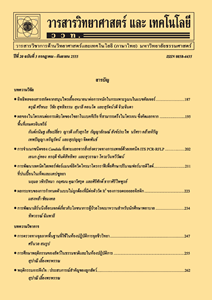การประเมินและออกแบบท่อแสงสำหรับอาคารในประเทศไทย
Main Article Content
Abstract
บทคัดย่อ
การวิจัยนี้มีวัตถุประสงค์เพื่อประเมินสมรรถนะและเสนอแนวทางในการนำแสงธรรมชาติผ่านระบบท่อแสง ในการวิจัยจะใช้โปรแกรม DIALux สำหรับการสร้างห้องจำลองเพื่อจำลองและวิเคราะห์สภาพแสง โดยจะพิจารณาสมรรถนะจากความส่องสว่างและค่าตัวประกอบแสงธรรมชาติภายในห้อง ผลการวิจัยทำให้ทราบถึงประสิทธิภาพในเบื้องต้นของระบบท่อแสงว่ามีความเป็นไปได้ในการนำมาใช้งานในประเทศไทย โดยการใช้ท่อแสงร่วมกับการใช้ช่องเปิดด้านข้างสามารถนำแสงธรรมชาติให้เข้ามาได้ในระยะ 7 - 8 เมตร และทำให้ส่วนที่ลึกที่สุดของห้องมีความส่องสว่างประมาณ 300 ลักซ์ ในสภาพท้องฟ้าโปร่งที่มีรังสีตรงจากดวงอาทิตย์ โดยสภาพท้องฟ้าโปร่งที่มีรังสีตรงจากดวงอาทิตย์ สภาพท้องฟ้าโปร่ง และสภาพท้องฟ้าครึ้ม จะส่งผลต่อปริมาณแสงที่เข้ามาในห้องมากตามลำดับ แสงอาทิตย์ที่ตกกระทบท่อแสงในมุมต่ำจะทำให้แสงสะท้อนเข้ามาในท่อแสงได้ดีกว่าแสงที่มาจากมุมสูง สำหรับแนวทางที่เหมาะสมสำหรับการออกแบบท่อแสงสามารถทำได้โดยการวิเคราะห์มุมตกกระทบของดวงอาทิตย์ในแต่ละทิศทางที่ต้องการใช้งานท่อแสง และกำหนดระยะยื่นของแผ่นสะท้อนแสงให้สัมพันธ์และสอดคล้องกับดวงอาทิตย์ อย่างไรก็ตาม การใช้ท่อแสงร่วมกับอุปกรณ์บังแดดประเภทอื่น ๆ ยังเป็นสิ่งที่จำเป็นเพื่อช่วยในการป้องกันและลดแสงจ้าบริเวณริมช่องเปิด
คำสำคัญ : ท่อแสง; แสงธรรมชาติ; สถาปัตยกรรม
Abstract
This research aims to assess the performance and propose the design guidelines of using light duct. DIALux’s models were used to simulate and analyze various variables including orientations and sky conditions. In terms of performance, the illuminance and daylight factor were assessed. The results indicated that the light duct is a potential mean to transport daylight into the deep inside area of a room. On the working plane at the distance of 7 - 8 meters from the window, the illuminance is approximately 300 lux under the clear sky with direct sun condition. For the light duct, the sky conditions with direct sun, clear sky, and overcast sky have a significant effect on the illuminance level in a space respectively. The daylight penetrating into the light duct in the lower angle performs better than that of the higher angle. To generate the better daylight performance, the vertical shading angle in each orientation should be considered, and the dimension of reflector should be related to the sun position. However, the integration of light duct and shading devices is required to shield and reduce the excessive daylight at perimeter zone.
Keywords: light duct; daylighting; architecture


